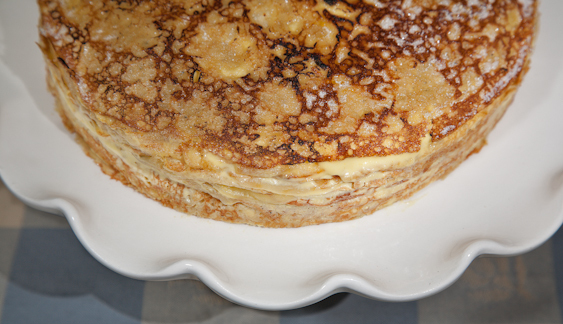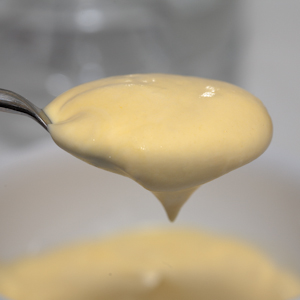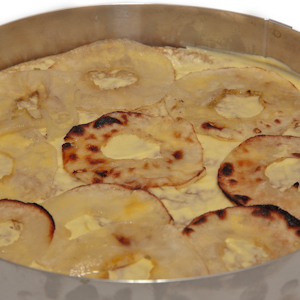Crêpe Cake with Roasted Apples and Reduced Cider Syrup

introduction
You might experience a wave of cognitive dissonance when comparing our glowing predilection for Plain Sugared Crêpes with the lofty visuals of this ensemble. Yes, the two could not appear to be more different. They do, however, share one important similarity: the appeal of eating crêpe-on-crêpe. In our opinion, crêpes are best consumed pleated or stacked upon themselves in tender, supple folds without a lot of interruption from things un-crêpe-like—such as surging waves of fruit, chocolate sauce, or cream. The configuration above possesses fruit, yes, but its apple slices are paper-thin and roasted until soft. It possesses cream, yes, but an ethereal blend of pastry and chantilly cream, and minimal amounts between each crêpe—just enough to offer a gorgeous bit of gilding. It is the crêpes themselves that make this dessert so brilliant—and they maintain their unique presence and resilience throughout.
A dinner party masterstroke, this cake is beautiful to gaze upon, light on the stomach, heavenly on the palate, and ready to slice without last minute heating, beating, or garnishing fracas (more on slicing in Baking Remarks). It fairly bursts with the flavors of Normandy in the crisp-to-chiffon crêpes and elegant cream, vividly tart roasted apple rings and bright cider syrup.
Think it looks difficult to make? Think again. If you can make a crêpe, you can make this cake.
Baking Notes
The mandoline, something of a French finger guillotine, is essential equipment for pitch-perfect apple or potato slices. Improvements in their design have made mandolines easier and safer to use since we shaved our fingers to the bone years ago. The ones with V-shaped blades best are generally considered the best.
We’ve simply got to tell you how tremendous a pastry ring is for an assembly of this sort. It has no bottom, so you don’t have to invert the cake and shake it loose—you just twist and lift! It holds the layers in perfect symmetry. (It also makes a wonderfully handsome quiche with high, straight sides and a bottom crust that browns directly through parchment on a stone.) Often called an entremet ring, we got ours (8 inches in diameter by 1⅜ inches high) at JB Prince for $15.
Another thing you’ll need to make this recipe is a cardboard round, which enables the cake to be lifted and transferred worry-free. Slip a long metal spatula under the round and slide the cake to the palm of you hand. At this point you can take it anywhere—even dancing. Cake rounds are available in pastry supply stores, real and online, and are a very easy do-it-yourselfer. Trace the diameter of the pan on a sheet of cardboard and snip. Voilà.
The cake round also provides a mercy cushion between the slicing knife and your china. And while we’re on the subject of slicing, it’s time to put in a pitch for the electric knife. Scorn of decades past, the thing that wounded our romantic soul most poignantly when our father plugged one into the dining room wall socket to carve the Christmas roast, demanding “Turn up the lights, Evelyn!” the electric knife is now a member in good standing of our batterie de cuisine. Nothing but nothing cuts through alternate layers of soft, solid, and slippery like an electric knife. It doesn’t drag its feet, it doesn’t lurch off-course, it goes to work and gets the job done. Typically maul your smoked salmon and cucumber finger sandwiches? Not anymore. Anyone who makes layered desserts or hors d’oeuvres needs one of these.
We don’t, however, recommend them for carving holiday roasts.
Then there is the kitchen torch. Flame is essential for producing the impossibly crisp caramel shell on the top of the cake. It’s not a step you’ll want to forego. Sure, you can buy a twee little butane crème brûlée torch for a lot of bucks, but we prefer our big ACE hardware classic—it never runs out of juice—and we feel like such a guy when we use it.
equipment mise en place
For this recipe, you will need a fine-mesh sieve; a deep, narrow bowl; a medium mixing bowl; a whisk; a small heavy-bottomed saucepan; a wooden spoon; a rubber spatula; a medium saucepan; a small pitcher or liquid measuring cup; two or three baking sheets; aluminum foil; a pastry brush; a peeler; an apple corer; a mandoline slicer; a thin metal spatula; parchment paper; an 8-inch-diameter, 1½-inch-high entremet ring mold or an 8-inch round cake pan; an 8-inch cardboard cake round; kitchen scissors; a small offset spatula; a long metal spatula; a propane or butane torch; and an electric or serrated knife for slicing the cake.
-
-
14just-made unbuttered and unsugared crêpes from Plain Sugared Crêpes, stacked in two columns on a baking sheet
-
-
for the pastry cream:
-
4large egg yolks
-
8ounces (1 cup) half-and-half
-
0.38ounces (about 1½ sifted tablespoons) Anson Mills Colonial Style Fine Cloth-Bolted Pastry Flour, sifted
-
Pinch fine sea salt
-
1.75ounces (¼ cup) granulated sugar
-
0.5ounce (1 tablespoon) cold unsalted European-style butter
-
¾teaspoon vanilla extract
-
⅓cup heavy cream, lightly whipped
-
-
for the cider syrup:
-
16ounces (2 cups) apple cider
-
¼cinnamon stick
-
-
for the apples:
-
1ounce (2 tablespoons) unsalted butter, melted
-
4tablespoons juice from 1 or 2 large, juicy lemons
-
3.5ounces (½ cup) granulated sugar
-
1.5pounds tart, relatively firm apples such as Gravenstein, Cortland, Pippin, Winesap, or Paula Red
-
-
for glazing the cake:
-
1½tablespoons granulated sugar, preferably superfine
-
-
Make the pastry cream: Set a fine-mesh sieve over a deep, narrow bowl. In a medium mixing bowl, combine the egg yolks and 1 tablespoon of the half-and-half, and whisk well. Add the sifted flour and whisk vigorously until the mixture is satiny smooth and free of lumps. Heat the remaining half-and-half, the sugar, and the salt in a small, heavy-bottomed saucepan over medium-high heat until simmering, stirring occasionally with a wooden spoon to dissolve the sugar. As soon as the mixture reaches a simmer, pull the saucepan off the burner and drizzle its contents slowly into the yolks, whisking constantly, until the saucepan is empty (fig. 1.1). Reduce the heat to medium-low, return the saucepan to the burner, and pour the warm yolk mixture back into the saucepan all at once, scraping the bowl with a rubber spatula and whisking the cream vigorously. Whisk the cream until it thickens and bubbles burst on the surface, 20 to 30 seconds. Allow it to bubble for 10 seconds. (Unlike crème anglaise, pastry cream is supposed to boil.) The cream should be thick and glossy (fig. 1.2).
-
Remove the pan from the heat and pour the pastry cream through the sieve, scraping the saucepan with a rubber spatula. Knock the cream through the mesh by tapping the rim of the sieve with the handle of a wooden spoon. Whisk in the cold butter and vanilla. Press plastic wrap directly against the surface of the cream and refrigerate until cold, about 4 hours or up to overnight.
-
Make the cider syrup: Add the cider and cinnamon to a medium saucepan and simmer the cider over low heat until syrupy and reduced to about ¾ cup, about 25 minutes. Remove and discard the cinnamon, transfer the syrup to a small pitcher or liquid measuring cup, and let cool to room temperature. Set it aside until ready to use. (The syrup may be made ahead and refrigerated, but is best served at room temperature.)
-
Roast the apples: Adjust an oven rack to the highest position and heat the broiler. Line 2 or 3 baking sheets (depending on how many you have) with aluminum foil and brush them with melted butter. Peel and core the apples one at a time and coat each one with lemon juice. Using a mandoline, slice the apples into rings about 1/16 inch thin. Lay the rings in a single layer on the prepared baking sheets, about 20 slices per pan. Sprinkle the apples with sugar and broil one baking sheet at a time until the apples are soft, spotty brown, and fragrant (fig. 4.1), 2 to 2½ minutes, rotating the baking sheet halfway through. Using a thin metal spatula, transfer the apple slices immediately to a fresh sheet of aluminum foil or parchment paper (otherwise they become glued to the foil as they cool).
-
Just before beginning the crêpe cake assembly, fold the lightly beaten whipped cream (fig. 5.1) into the chilled pastry cream. The cream will be light and airy (fig. 5.2). Set it aside.
-
Assemble the crêpe cake: Line a baking sheet with parchment paper. If you are using an 8-inch-diameter, 1½-inch-high entremet ring, fit an 8-inch cardboard cake round into the bottom and set the ring on the baking sheet. If you are using an 8-inch cake pan, coat it lightly with vegetable oil spray and line the bottom with a parchment paper round. Trim any straggly or oversized crêpes with scissors. Place a crêpe in the bottom of the ring or cake pan; if you are using a cake pan, make sure to lay the first crêpe lacy side down as it will ultimately be the top layer of the cake. Using a small offset spatula, spread a thin layer of pastry cream over the crêpe. Lay a second crêpe on top. Spread the second crêpe with a thin layer of cream (fig. 6.1), and then arrange a layer of apple slices on the cream (fig. 6.2). Repeat this pattern, spreading pastry cream on every crêpe layer and arranging apple slices on every other. Ultimately, there should be 6 layers of apple slices. The top two layers of the cake should be crêpes and pastry cream only; do not spread pastry cream on the final crêpe layer.
-
Serve the cake: If you used an entremet ring, twist it slightly, and then lift it off the cake. If you used a cake pan, run a metal spatula around the pan’s circumference and lay a cardboard round on the top; invert the cake pan and cardboard round together to unmold the cake, and then lift off the parchment round. To glaze the cake, sprinkle the superfine sugar over the top and caramelize the sugar by running a propane or butane torch lightly over the surface. You may hold the cake at cool room temperature for up to 4 hours under a cake dome before serving. Refrigeration does not enhance its delicate nature. To serve, cut the cake into wedges with an electric or serrated knife. Drizzle individual servings with cider syrup.
-
-
1.1

-
1.2

-
-
-
4.1

-
-
-
5.1

-
5.2

-
-
-
6.1

-
6.2

-